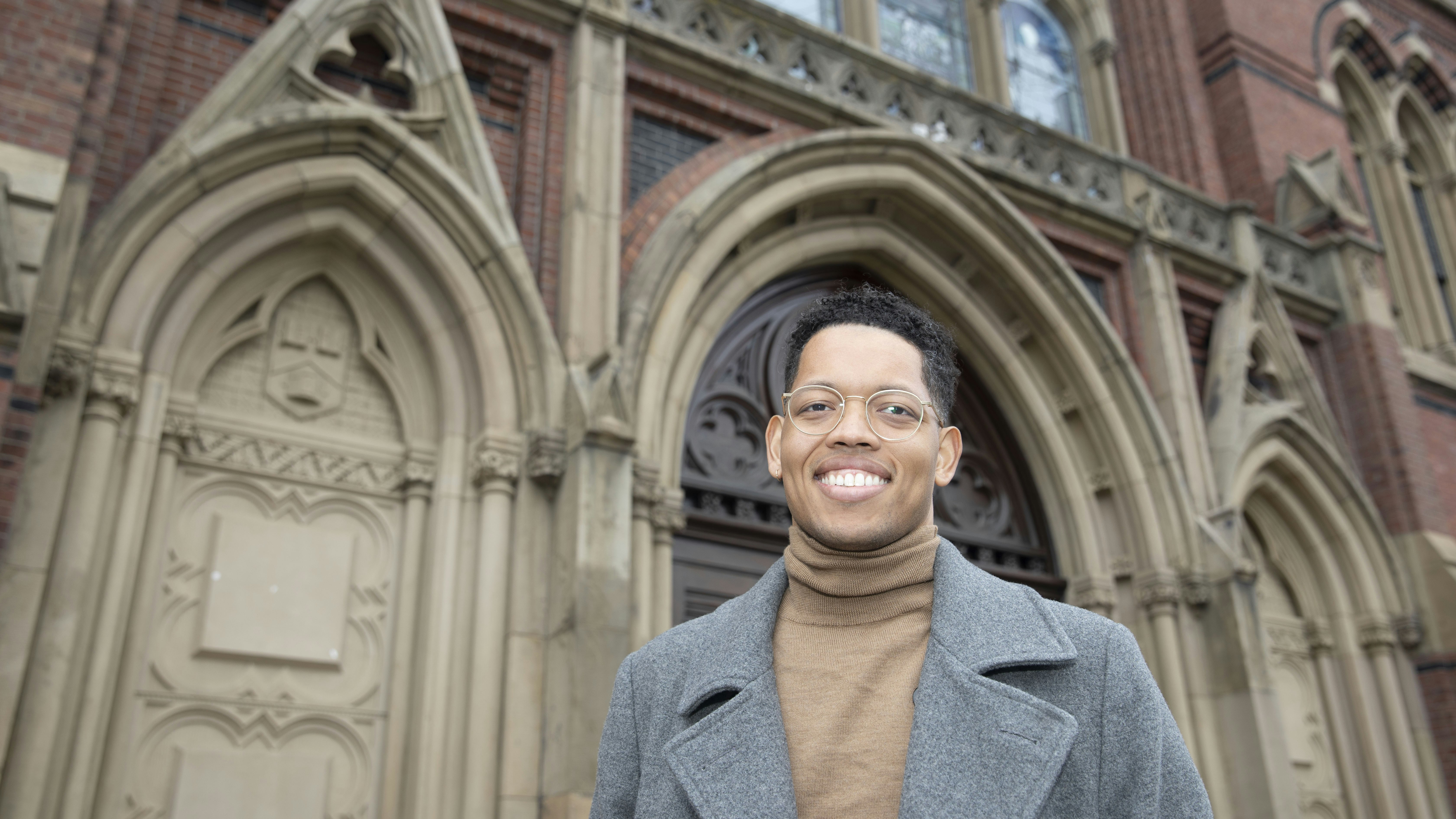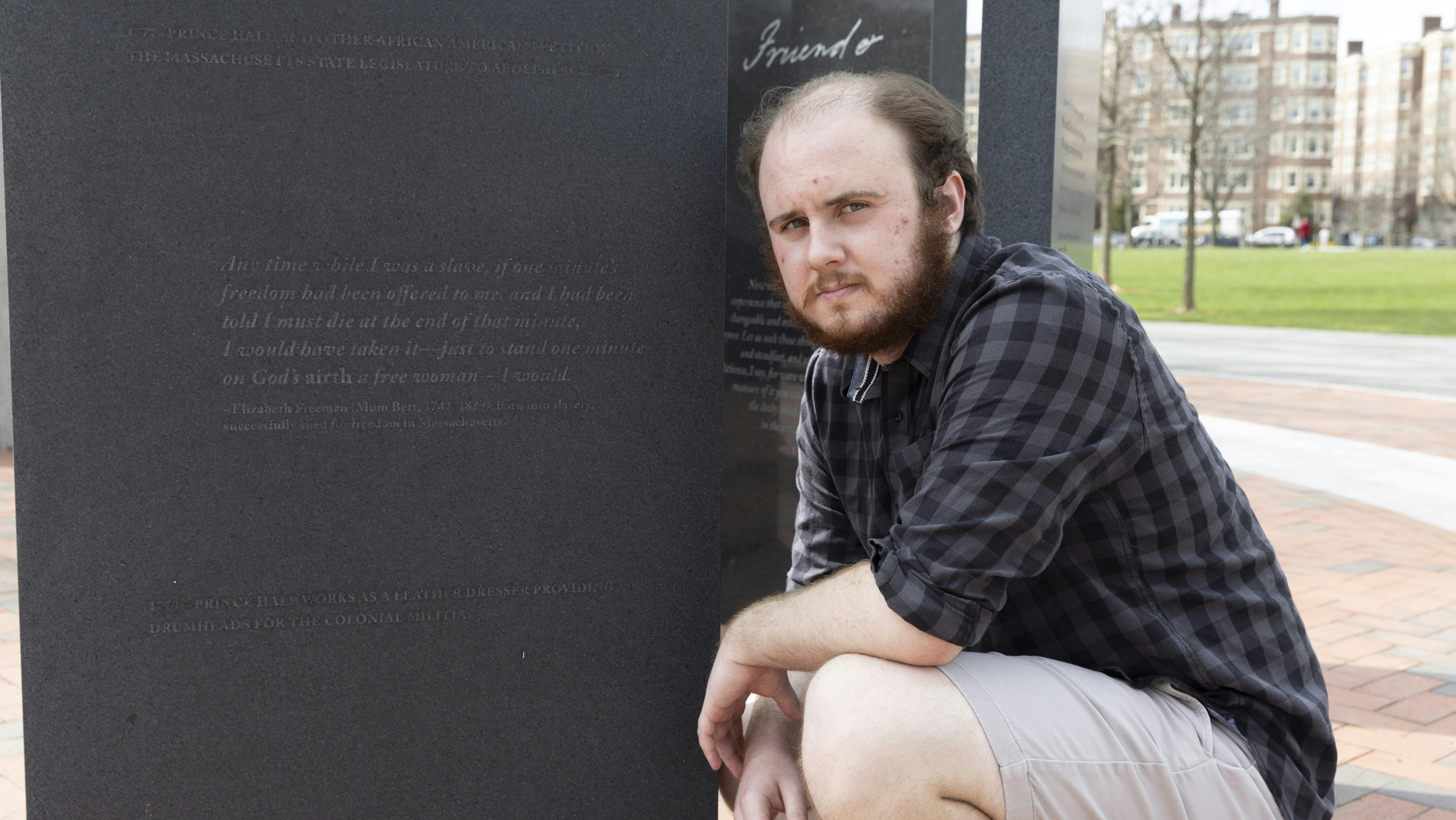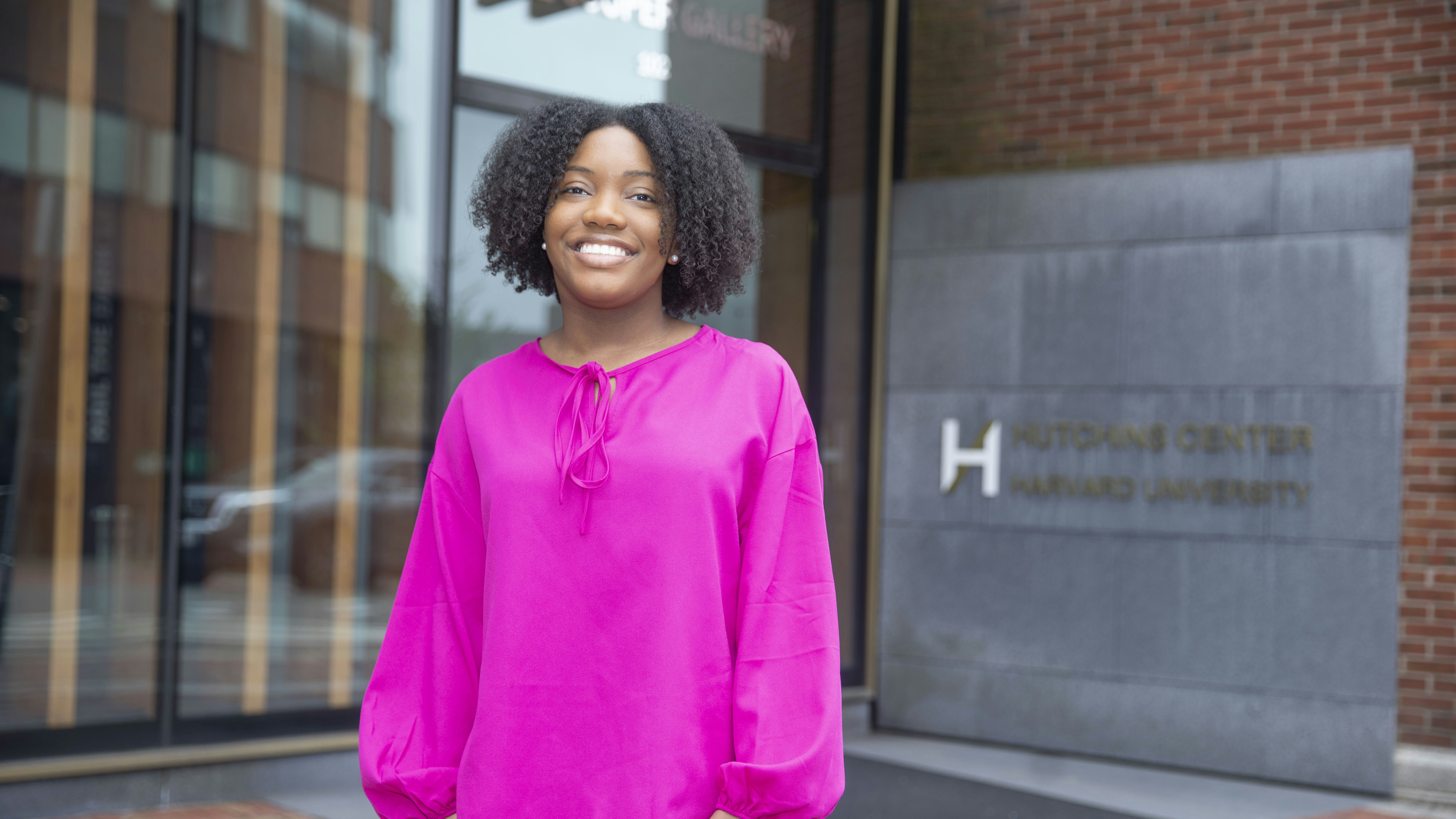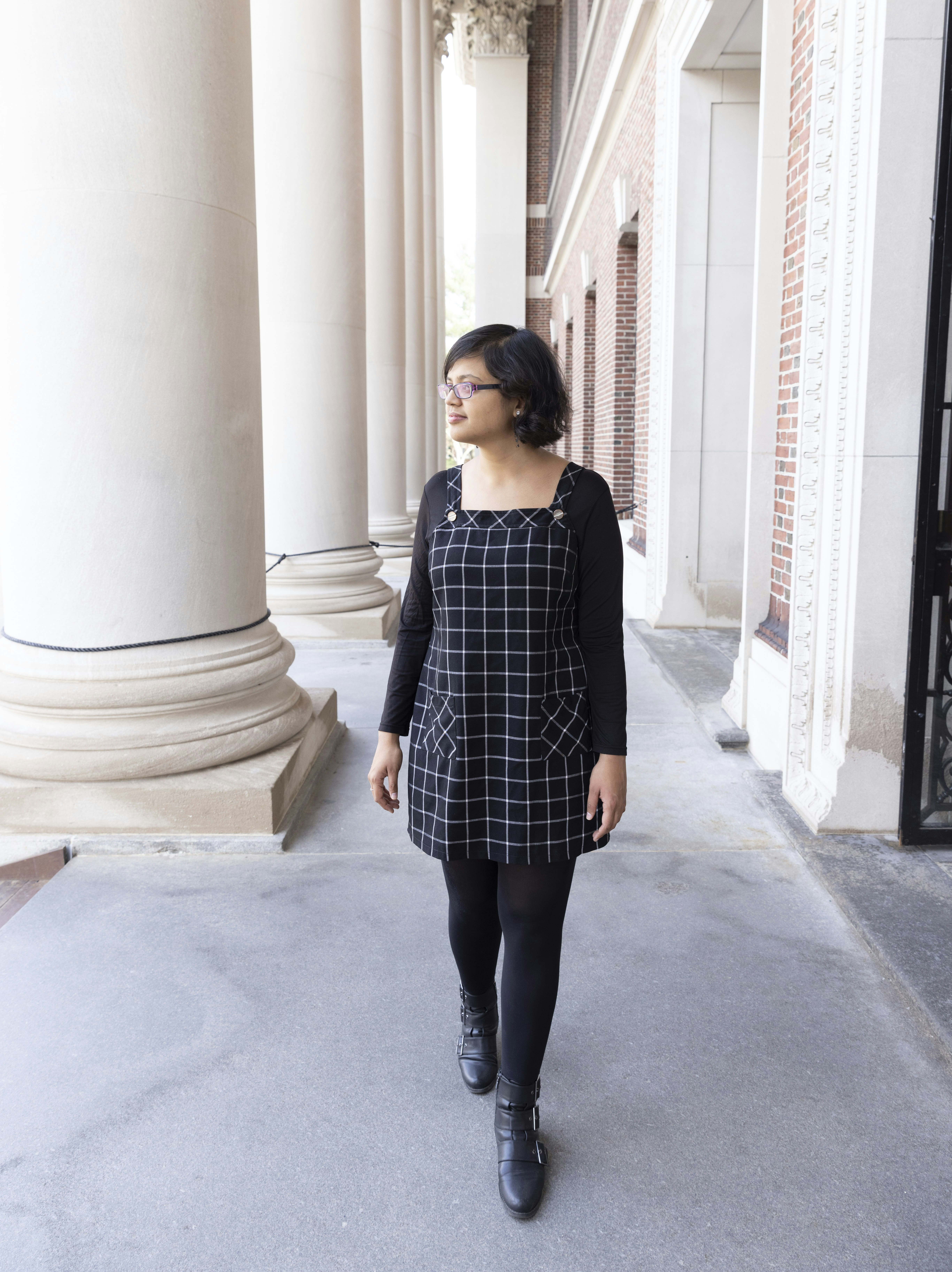Harvard’s Tour App Highlights Overlooked History

Veritas, the Latin word for “truth” and Harvard’s motto, is visible all around the University’s campus—indoors and out and in myriad forms. Look above the door of Widener Library and it appears sculpted in stone. It is etched in stained glass in Memorial Hall’s transept and worked in metal on a Harvard Yard fence and a gateway to Harvard’s Soldiers Field in Allston, to name just a few places and forms.
Nearly four centuries after it was first adopted as Harvard’s official motto, Veritas will take on even greater weight and meaning when the Presidential Initiative on Harvard & the Legacy of Slavery (H&LS) report and recommendations are released.
To help make the report’s findings more tangible, Alexandria Russell, the HL&S research fellow focused on digital humanities, worked with colleagues at Harvard Radcliffe Institute to create a tour that participants can explore virtually or in real life. The tour connects historical sites on and off campus to the University’s involvement with enslavement, and it also honors Black excellence and achievement.
“The H&LS initiative’s goal was to convey major themes of the report while also allowing visitors to reconceptualize spaces and historical narratives that they likely have already encountered,” said Russell, who chose an impressive and diverse group of undergraduate and graduate students to serve as virtual tour guides. “The students walk past these tour stops daily and certainly have opinions about many of them. These students are exploring the University’s past, and changing and growing in each phase of their educational journey here.”
Keep reading to get a sneak peak of some of the featured sites and to hear the students’ illuminating perspectives about Harvard and Veritas.
Discovering a Hero
Each day on his way to class during the 2019–2020 academic year, Noah Gold ’22 would dash across Cambridge Common solely focused on getting to class on time. Before submitting an application to be a voice actor for the Harvard & the Legacy of Slavery initiative tour app, he never realized the park is a “veritable outdoor museum.”
Gold, who hails from Potomac, Maryland, was also surprised to learn Harvard University had anything to do with slavery. “I feel like it’s an important enough topic that everybody should have heard of it,” he explained. “It made me think more in-depth about how Harvard and slavery coexisted and how the University clearly benefited from slavery.”
Once Gold received his assignment for the tour, he conducted research on Prince Hall, a Black Bostonian who the City of Cambridge commemorated in 2010 with a memorial in Cambridge Common for his efforts to abolish slavery and support enslaved and freed Blacks.
“He hosted all these events and raised funds to make sure that even the people who were still enslaved had a better quality of life,” Gold said. “He brought the fight to the political realm, to the judicial realm. Unfortunately, slavery in the United States didn’t end until about 100 years later, but he still made a lasting impression.”
Newly armed with this knowledge, Gold discovered that his friends were just as uninformed about Harvard’s role in slavery and the slave trade as he was. He also has discussed the tour with his entire family, and he is committed to walking the tour with them when they attend his graduation.
Gold would like to see Harvard make its historical entanglement with slavery and its legacies part of its future core curriculum. He expressed shame about passing the Prince Hall Monument daily without a thought, without knowing who Hall was, because he feels it reflects a powerful bias in American history classes and textbooks.
“I think people really need to know that Cambridge—and, I mean, the colonies in general—were not just a place where revolution happened, where the freedom of America was born, but where even in the midst of their fight for the nation’s freedom, there were people who were actively enslaved by those same people who were arguing for life, liberty, and justice for everybody,” Gold said.

Noah Gold '22, who voices the Cambridge Common stop on the Harvard & the Legacy of Slavery tour, was surprised to learn the history of slavery in Boston. Photo by Kris Snibbe
Reconciling the Memory of an Enslaved Past
Memorial Hall is a striking Victorian structure completed in 1878 to commemorate Harvard students, alumni, and faculty who died serving in the Union Army during the Civil War. In addition to the transept, a breathtakingly beautiful inner space with stained glass windows and a marble floor, Memorial Hall is home to Harvard’s first-year dining room, Annenberg Hall. Also a memorial, Annenberg honors Harvard’s renowned graduates and administrators in portraiture and sculpture—all white men until 1993, when a marble bust of W. E. B. Du Bois, the first African American to earn a PhD from Harvard, was added to the collection.
“Memorial Hall was Harvard’s attempt to support abolition in the abstract without doing the work that it needed to do to actually advance racial equality in this country,” said first-year Harvard Law School (HLS) student Robert Clinton, who narrates the site in the tour. “It’s a memorial to the people who fought in the Civil War, but not a memorial to the people who were impacted by what the Civil War was about, which is slavery.”
The Richmond, California, native chose Harvard Law School (HLS) in part because, well, “Harvard is Harvard,” and a degree from HLS will help position him to influence public policy and make an impact as a criminal defense attorney. “But I also did some research on the ways that Harvard was reacting to racial inequality in the aftermath of the 2020 killing of George Floyd,” he explained. “I wanted to know that I was going to a university that was thinking critically about its relationship with racial inequality.”
That’s when Clinton dug up information about the law school’s former shield, which incorporated the family crest of Isaac Royall Jr., whose family wealth came from slavery and helped establish the law school. This sparked a desire in him to help build awareness about Harvard and slavery for himself and his peers.
“The fact that this institution is here because of exploitation and slavery is something that people are often surprised by. People who were enslaved were on this campus that we go to, so I wanted to help out however I could,” he said. “There are lots of [different kinds of] memorials to lots of different people here already, so clearly there’s a willingness to engage with the institution’s history—but not with the entirety of the history, so I’m glad it’s finally happened.”
The University should be mindful of that history when reviewing Black students’ applications for admission and financial aid, said Clinton. “I’m not exactly sure what that looks like, but I do think that it’s worth acknowledging that there were years and years when the University didn’t admit Black people and years and years when the University was able to grow and sustain itself on the backs of Black labor. We need to help right that by making sure that this place right now is not only welcoming for the Black people who are here but also encourages Black people to apply while thinking specifically about that exclusion and exploitation from the past when evaluating [future] Black candidates.”

Kyra March '22 found an intellectual community when she worked as a research assistant at the Hutchins Center, and she was excited to narrate that stop on the tour. Photo by Kris Snibbe
A Space to Intellectually Engage Black History
Under the leadership of Henry Louis Gates Jr., the Hutchins Center draws scholars from all over the world to celebrate Black history, culture, and artistry. Originally established in 1975 as the W. E. B. Du Bois Institute for Afro-American Research, the Hutchins Center was established in 2013 to house not only the Du Bois Institute, but also the Image of the Black Archive & Library, the Celia and Henry W. McGee III Black Film Poster Collection, and innovative learning resources like the Hiphop Archive & Research Institute.
The center boasts a wide range of programs and some of the nation’s most renowned scholars of Black studies but also is a space that provides both refuge and joy to students like Kyra March ’22, who is concentrating in African and African American studies and studies of women, gender, and sexuality, with a citation in Gullah, the creole language of African Americans living in the Lowcountry from North Carolina to Florida.
In Summer 2021, March received a grant from the Harvard & the Legacy of Slavery initiative to work on her thesis about the Cambridge home of Harriet Jacobs, a formerly enslaved woman who famously published an autobiography documenting her experiences, and the absence of memorials to Black women. This semester, with support from a second H&LS grant, she’s working on digitizing her project.
March, who aims to become a museum curator, leapt at the opportunity to voice a stop for the tour and was thrilled to learn she would introduce the Hutchins Center, where she had previously worked as a research assistant.
“It is a place where you can engage with Black people and Black history on an intellectual level, and [which you can] also use as a safe space for Black people on this campus,” she said. Deeply grateful to both the Hutchins scholars and staffers she has gotten to know and work with these past four years, she said the center “is a really good community space where I felt like I had people around me who cared and that I could talk to.”
March, a South Carolina native, has been researching her family’s connection to slavery with her grandmother. So far, they’ve uncovered a great-grandfather and a great-great-grandfather who were born on plantations, presumably into enslavement. Coming from the South, she was not surprised to learn of Harvard’s ties to enslavement, although she was disappointed. March hopes the University will use the forthcoming report as well as physical memorials that still honor enslavers to educate the Harvard community and the public about University benefactors whose great wealth was built from slavery. While there are plaques and monuments acknowledging enslaved people at Harvard Law School and at Wadsworth House, she also hopes the University will add more memorials to honor the lives of other enslaved people to provide a fuller picture of the University’s history.
“I think that when the H&LS report comes out, people will want to engage more with the subject and do a lot more research to figure out how to honor them,” said March. She believes it will be a reality check for people who tend to put Harvard on a pedestal and “will force people to think about how there are so many important aspects of history that have been hidden that we should be seeking.”
The Harvard & the Legacy of Slavery Initiative will also celebrate African American excellence and the achievements of the University’s Black alums, including Alberta V. Scott, Radcliffe’s first Black graduate. March says that “seeing people like them and their lives and accomplishments just encourages me and reminds me that we have a place here and we deserve to be here.”

Mini Saxena LLM ’22, who introduces Widener Library on the tour, hopes the Harvard & the Legacy of Slavery report will spark more substantive changes. Photo by Evgenia Eliseeva
Widener Library’s Foundation in Black and White
Widener Memorial Library is the centerpiece of Harvard’s library system and one of the nation’s largest libraries—but how many people know that it sits on land donated by a slaveholder? Or, on the other hand, that Julian Francis Abele, the first African American graduate of the University of Pennsylvania’s architecture program, was one of the chief architects of this iconic Harvard building?
As Mini Saxena LLM ’22 walked through Harvard Yard toward Widener to prep for her tour assignment, she was immediately struck by how imposing the limestone and red brick structure is. Peering through the pillars that envelop it, she gazed up and saw Harvard’s motto, Veritas, etched in stone above the building’s heavy doors.
“It made me feel that this building houses not just the truth but all the truth that there is in the world,” Saxena recalled. “At the same time, I also was struck by this question of access. Who feels at home here, and who has access to this slightly intimidating structure?”
As she explored the building’s different levels, she pondered that some of the knowledge found in Widener’s more than three million books is available to just a certain group of people. More importantly, she thought, what would or could people who do not have this access do with that knowledge? She thought of the caste system in her native India, which historically denied members of lower classes access to knowledge or books not meant for them.
Throughout her self-guided tour, Saxena felt a strange kinship with Abele and wondered whether the lack of credit for his work grated on him or was taken in stride. It also made her wonder whether she is giving enough credit to scholars of color who are cited in her own work. Once people learn that Widener was designed by a Black architect whose work was co-opted, they may process the building differently.
“I think it’s important to reconstruct that memory and keep it alive,” said Saxena. “[Abele] is an example of someone who overcame challenges to get a good education and contribute to a really significant architectural piece of his time, but he also is an example of how those contributions get overshadowed.”
Saxena hopes that Harvard will make changes, both big and small, after the release of its H&LS report.
Harvard Law School students would like the student lounge in the Caspersen Student Center to be named after Belinda Sutton, whom HLS benefactor Isaac Royall had enslaved. In fact, as a form of protest, students have been referring to it as Belinda Hall for years.
“It’s a really small measure, and the fact that it hasn’t been accepted is indicative of the battle we have ahead of us,” she said. “I would like to see much more substantive changes,” including syllabus overhauls and a more diverse faculty.
“Once the report comes out, I want people to read it and realize that this institution not just has a legacy of slavery but has been complicit in slavery—and to some extent is still complicit, not so much in slavery but certainly in oppression of other kinds,” Saxena said. If she is ever in a position of pedagogical power, the future scholar added, she will work to ensure that everyone in her classroom feels like they belong and hopes that, moving forward, Harvard will support students who, for whatever reason, may feel they don't belong and consider what the University can do to change that.







